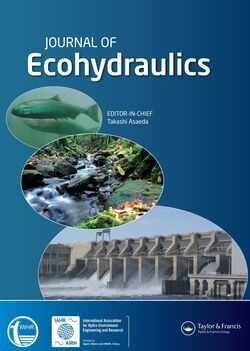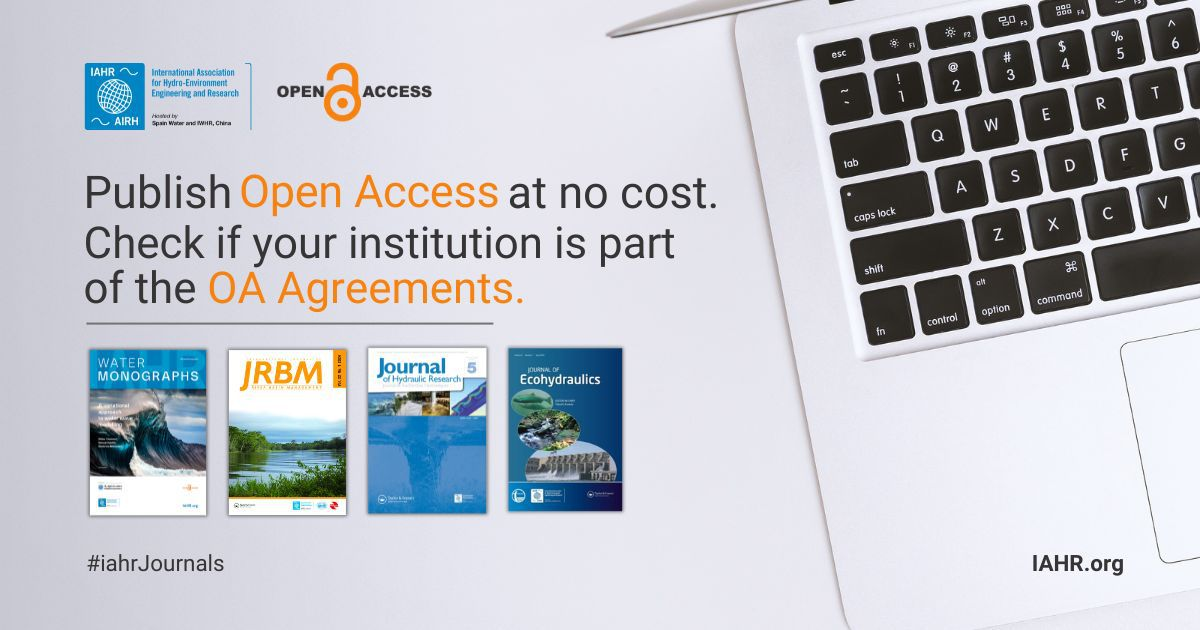Journal of Ecohydraulics | Volume 9, Issue 2/2024
 The Journal of Ecohydraulics (JoE) is an international, peer reviewed journal, publishing high-quality, original research. It publishes varied research undertaken in ecohydraulics, covering water resources and aquatic life, ecology, biology, hydraulics, engineering, geoscience, environmental science, climate change, and other related fields, with an emphasis on the integration of these disciplines and the contributions they can make for a sustainable future.
The Journal of Ecohydraulics (JoE) is an international, peer reviewed journal, publishing high-quality, original research. It publishes varied research undertaken in ecohydraulics, covering water resources and aquatic life, ecology, biology, hydraulics, engineering, geoscience, environmental science, climate change, and other related fields, with an emphasis on the integration of these disciplines and the contributions they can make for a sustainable future.
The Journal of Ecohydraulics was listed in SCOPUS last year, and the 1st time journal metrics (2022) were generated, as CiteScore 5.4 (Q1), SNIP 1.016, and SJR 0.676.
IAHR members can access the latest issue online.
Non IAHR members must access through Taylor & Francis website.
Overview
This issue of the Journal of Ecohydraulics brings together important research focused on fish passage, habitat restoration, and innovative solutions for aquatic systems. Several articles address fish passage and migration, including studies on improving the movement of migratory species like American Shad over man-made barriers. Key insights are shared on retrofitting structures like streamgage weirs to enhance fish passage without removing them. Other studies delve into the hydraulics and design of fishways, particularly vertical-slot and rock-weir fishways, offering critical findings for more efficient design. Aquatic habitat modeling and restoration efforts are also a focal point. One article compares hydrodynamic models to better understand friction in river systems, while another highlights the success of constructed spawning and rearing channels in Finland, designed to compensate for habitat loss caused by hydropower development. This research shows promising results in restoring habitats for species like brown trout.
In terms of fish behavior and performance, two experimental studies explore the swimming performance of small fish species, emphasizing the role of in-flume habituation and the minimal impact of tagging on swimming behaviors. These findings are vital for accurately assessing fish performance in both natural and controlled environments. A couple of articles focus on egg transport and larval dispersal, investigating the dynamics of fish egg movement, particularly for European nase, and the dispersal of endangered sturgeon larvae in large river systems. These studies underscore the importance of channel morphology and hydraulic conditions for effective conservation strategies. Additionally, this issue features innovative techniques for environmental monitoring and species management. A newly developed portable particle image velocimetry system shows potential for low-cost, accurate measurement of turbulence in aquatic environments. There's also research on using a bubble screen as a non-intrusive barrier to limit the downstream spread of invasive carp eggs, providing a new method for managing invasive species.
Lastly, a comprehensive review of Nature-Based Solutions (NBS) for urban stormwater management emphasizes their multifunctionality and potential benefits. However, the review also highlights the need for more thorough, large-scale evaluations to better assess their long-term effectiveness.
Articles
Effect of backwatering a streamgage weir on the passage performance of adult American Shad (Alosa sapidissima)
Kevin B. Mulligan, Alex Haro and John Noreika
Pages: 145-157 | DOI: 10.1080/24705357.2021.1945500
Hydraulics and design of fishways II: vertical-slot and rock-weir fishways
Abul Basar M. Baki and Amir H. Azimi
Pages: 158-170 | DOI: 10.1080/24705357.2021.1981780
Sensitivity of aquatic habitat modeling to hydrodynamic calibration
Ludovic Cassan, Hélène Roux, Dominique Courret and Sylvain Richard
Pages: 171-179 | DOI: 10.1080/24705357.2022.2049014
Performance of constructed fish spawning and rearing channels – development of the Imatra City Brook in Finland |
Jukka Jormola, Antti Haapala, Kirsti Leinonen, Markus Tapaninen, Pekka Vähänäkki and Saija Koljonen
Pages: 180-191 | DOI: 10.1080/24705357.2022.2090456 | ![]()
Characterizing egg transport of Chondrostoma nasus (L.): a combined laboratory and field experiment
Susanne Scherbaum, Christoffer Nagel, Yannic Fuchs and Juergen Geist
Pages: 192-202 | DOI: 10.1080/24705357.2022.2102089
Low-cost field particle image velocimetry for quantifying environmental turbulence
Kaylin Jones and Aline J. Cotel
Pages: 203-217 | DOI: 10.1080/24705357.2023.2248986
Urban stormwater management from the perspective of nature-based solutions: a bibliometric review
Ronaldo Adriano Alves, Anderson Paulo Rudke, Leila Droprinchinski Martins, Sueli Tavares de Melo Souza, Alessandro Botelho Bovo, Marcos Jeronimo Goroski Rambalducci and Jorge Alberto Martins
Pages: 218-238 | DOI: 10.1080/24705357.2023.2284392
The effect of in-flume habituation time and fish behaviour on estimated swimming performance |
Muhammad Usama Ashraf, Daniel Nyqvist, Claudio Comoglio and Costantino Manes
Pages: 239-247 | DOI: 10.1080/24705357.2024.2306411 | ![]()
Survival and swimming performance in small-sized South European Cypriniformes tagged with passive integrated transponders
Daniel Nyqvist, Alfredo Schiavon, Alessandro Candiotto, Fabio Tarena and Claudio Comoglio
Pages: 248-258 | DOI: 10.1080/24705357.2024.2306419
The influence of channel morphology and hydraulic complexity on larval pallid sturgeon (Scaphirhynchus albus) drift and dispersal dynamics in the Fort Peck Segment, Upper Missouri River: insights from particle tracking simulations |
Bruce C. Call, Richard R. McDonald, Susannah O. Erwin and Robert B. Jacobson
Pages: 259-287 | DOI: 10.1080/24705357.2024.2312837 | ![]()
Limiting downstream dispersal of invasive carp egg surrogates using a laboratory-scale oblique bubble screen |
Vindhyawasini Prasad, Cory D. Suski, P. Ryan Jackson, Amy E. George, Duane Chapman, Jesse R. Fischer and R. O. Tinoco
Pages: 288-307 | DOI: 10.1080/24705357.2024.2332994 | ![]()
Evaluating hydrodynamics and implications to sediment transport for tidal restoration at Swan Cove Pool, Virginia
Jin Ikeda, Peter Bacopoulos, Celalettin E. Ozdemir, Bartholomew Wilson, Matthew V. Bilskie and Scott C. Hagen
Pages: 308-330 | DOI: 10.1080/24705357.2024.2347217

